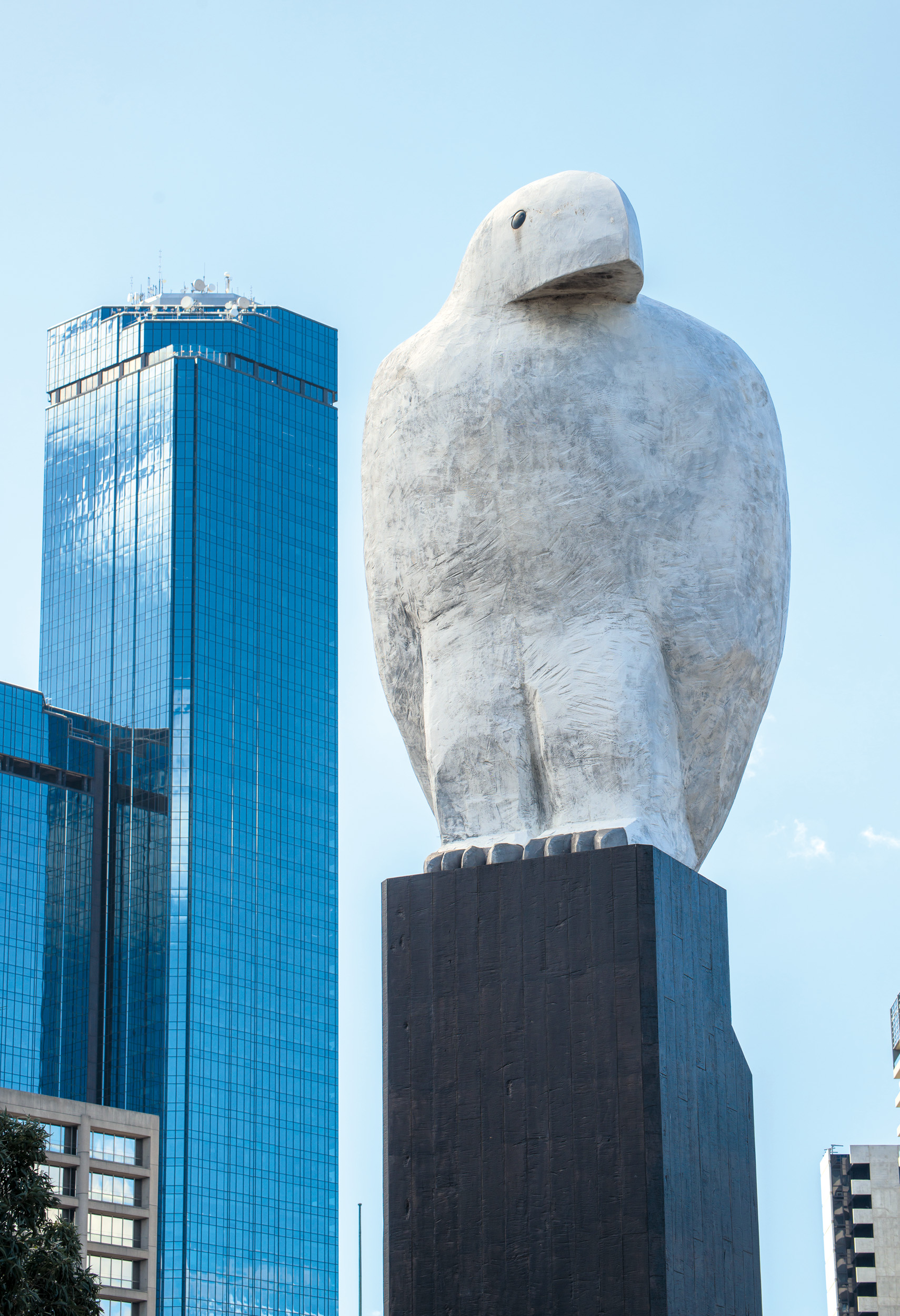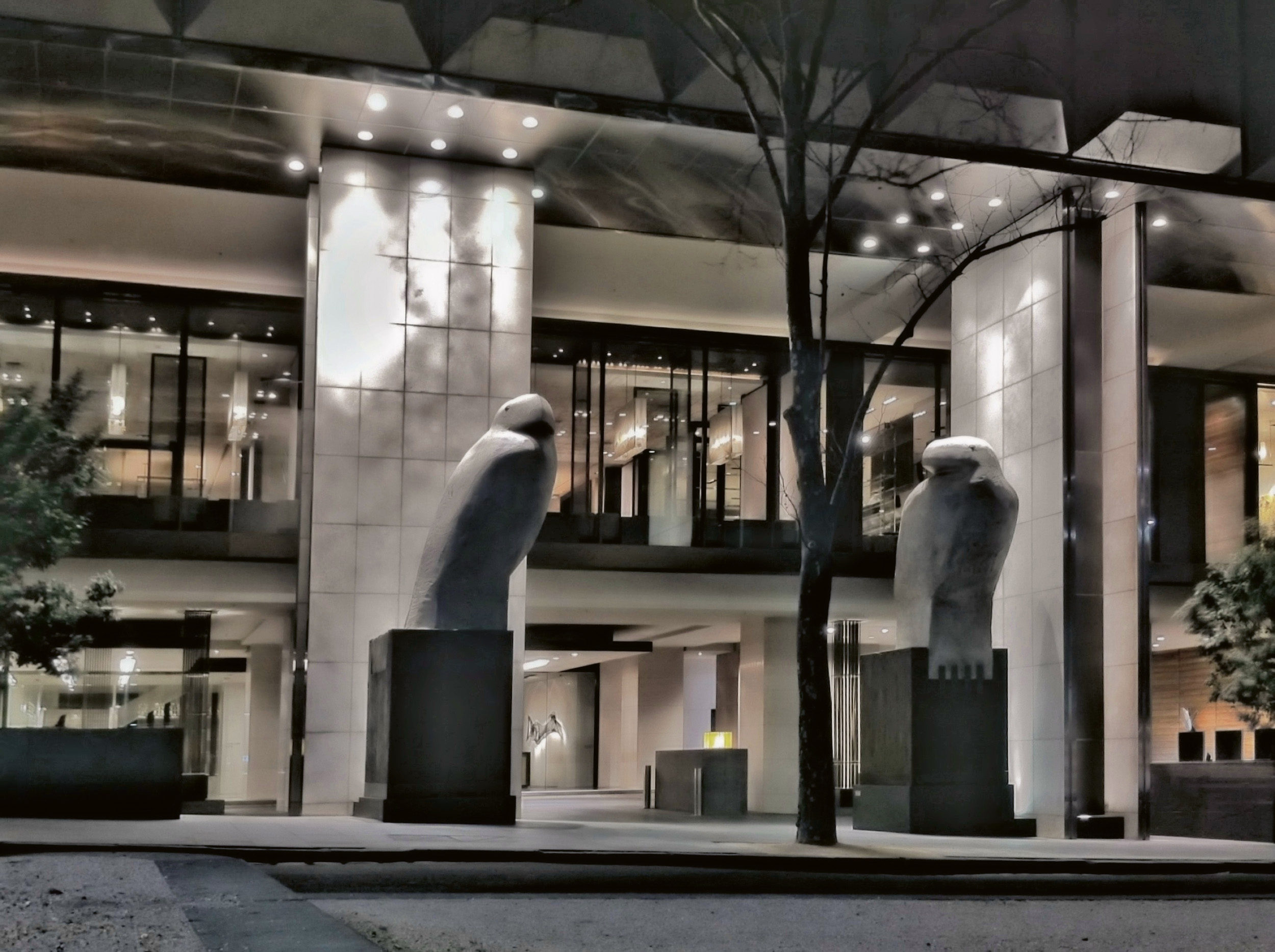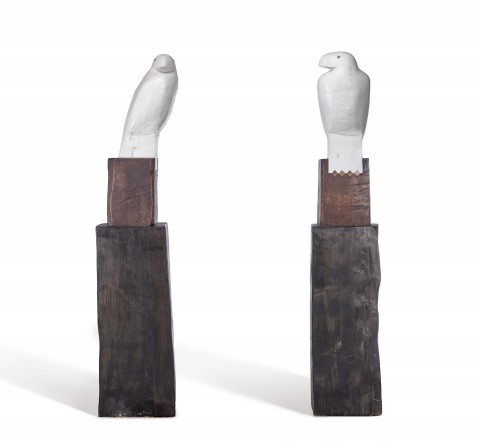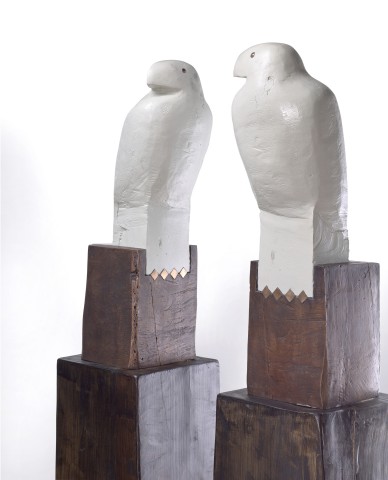GUARDIANS [PAIR OF MAQUETTES FOR THE GRAND HYATT HOTEL, MELBOURNE], 2009 – 2021
BRUCE ARMSTRONG
cast and painted bronze on timber bases
205.0 cm (height, each, including base)
i. edition: 6/10
i. signed with initials and numbered at base: BA / 6/10 422
ii. edition: 7/10
ii. signed with initials and numbered at base: BA / 7/10 / IRO
& Gallery, Victoria
Private collection, Victoria, acquired from the above in 2021
230211 Bruce armstrong docklands HIGH RES_cmyk.jpg

The massive hewn beasts that form Bruce Armstrong’s mystical menagerie have safeguarded Melbourne’s urban environment for decades. Sculpting from fallen trunks, often hundreds of years old, Armstrong has steadfastly persisted with a style of art making reliant on brawn and a high degree of technical craftsmanship. Beginning with illustrious commissions in the late 1980s, most notably Guardians, 1987, the pair of crouching beasts standing at the entrance of the National Gallery of Victoria, Armstrong has made a career of creating monumental totemic figures built to exist in the open public space. For Melburnians, the public installation of his three landmark eagles – the 23m tall Bunjil, 2002 surveying the Docklands and the pair of aquiline Guardians, 2009 installed at the entrance of the Hyatt Hotel – have changed the aesthetic fabric of the city and provided the urban environment with a deeper, more spiritual connection to the land.
Placed upon robust plinths replicating rustic wooden beams, and gleaming with a simple tonal contrast and subtle polished metal details, these Guardians, 2009 – 2021 are editioned bronzes, recreating in a domestic scale the imposing and memorable format of Armstrong’s Guardians at the Russell Street entrance of Melbourne’s Hyatt Hotel. They are turned with heads cocked in static and silent dialogue, omniscient and ever watchful. Painted a uniform white with pigments mixed with marine acrylic (a defensive weather patina), the Guardians stand proud with a striking silhouette. Their smoothed simplified shapes embody the Wedge-Tailed Eagle, Australia’s largest bird of prey and a significant figure in local Indigenous mythology.
An ancestral being, one of two moiety forebears, Bunjil, the Wedge-Tailed Eagle holds a central role in the creation stories of the Boon Wurrung and Woi Wurrung language groups of the greater Kulin Nation of south-eastern Australia. In addition to creating the land and its features, Bunjil was said to have made people by breathing life into clay figures and exerted control over rising seas threatening the habitability of their lands.1
Armstrong’s sculptural (and two dimensional) work embraces the folkloric and animistic potential of animals, drawing inspiration from long standing traditions in American, Egyptian, Hawaiian and indigenous Australian cultures. His figures have a physical and psychological presence without referring back to a specific mythology, purely utilising emotional effects of the muscular formal qualities of his sculptures. In an interview conducted during his 2018 survey exhibition at the National Gallery of Victoria, Armstrong acknowledged that while his Docklands Bunjil was not created with the Indigenous significance in mind, he appreciated the organic links that were later formed with First Nations Australians and the exposure it gave to the creation stories around Bunjil for local groups.2
Bruce Armstrong, a self-confessed twitcher and having idealised himself as a falconer within a 2005 self-portrait3, writes: ‘Bird’s are everyone’s allegory, a totem for all personalities. Every culture has bird stories… one can sift through the history of art and find images of birds in the earliest of humanity’s imagery.’4 His oeuvre is peppered with avian forms, most devoid of detail and adopting a symbolic shape of varying simplification. Some resting, others using their outspread wings as protective, encircling shields. Based on an early maquette from 1996, the docklands Bunjil had prominent, defined legs and talons gripping the plinth behind which fell his folded wings and tail. This present pair of Guardians, based on a later design, features a simpler form which smooths the eagle’s turned head, body and legs into one even and uniform plane. Unlike the public monumental versions, their talons are symbolically chiselled into the base in a chevron pattern, inlaid with gleaming bronze diamonds.
230211_Hyatt_cmyk.jpg

Although cast in bronze, an effect of carved muscularity is retained through the preserved chisel marks, rustic clefts and ridges left unpolished on the surface of the sculpture. Armstrong sustainably sources his wood from trunks destined for mulching and honours the long survival they have endured throughout history by keeping a tactile materiality and authentic roughness to his finished sculptures. Armstrong creates a curious tension between the dense mass of his sculptures, and the aerial verticality of his avian forms perched atop totem poles.
From this high vantage point, the Guardians survey the area, one looking straight out and the other turned to the side, eyeing the periphery. They do not simply mirror each other, instead displaying an organic duality, more closely linked to the environment in which they are placed. Endowed with a commanding presence, these watchful sentinels are intended to be placed on either side of an entrance to a place of cultural significance. With an endearing untidiness, Armstrong’s Guardians are raw and vernacular, their simplicity providing a blank canvas for interpretation and engagement with each environment and viewer.
1. Bunjilaka Aboriginal Cultural Centre, Museums Victoria, see: https://museumsvictoria.com.au/bunjilaka/about-us/ (accessed June 2023)
2. Armstrong in conversation with David Hurlston in Bruce Armstrong. An Anthology of Strange Creatures, National Gallery of Victoria, Melbourne, 2018, p. 4
3. Self Portrait, 2005, acrylic on board, 157 x 127 cm, entered in the 2005 Archibald Prize: https://www.artgallery.nsw.gov.au/prizes/archibald/2005/28082/ (accessed June 2023)
4. Armstrong, B., ‘Why Birds?’ in Webb, V., MCA Unpacked II: Six Artists Select from the MCA Collection, Museum of Contemporary Art, Sydney, 2003, p. 8
LUCIE REEVES-SMITH

